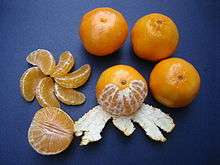Clementine

| Nutritional value per 100 g (3.5 oz) | |
|---|---|
| Energy | 198 kJ (47 kcal) |
|
12.02 g | |
| Sugars | 9.18 g |
| Dietary fiber | 1.7 g |
|
0.15 g | |
|
0.85 g | |
| Vitamins | |
| Thiamine (B1) |
(7%) 0.086 mg |
| Riboflavin (B2) |
(3%) 0.030 mg |
| Niacin (B3) |
(4%) 0.636 mg |
| Pantothenic acid (B5) |
(3%) 0.151 mg |
| Vitamin B6 |
(6%) 0.075 mg |
| Folate (B9) |
(6%) 24 μg |
| Choline |
(3%) 14 mg |
| Vitamin C |
(59%) 48.8 mg |
| Vitamin E |
(1%) 0.20 mg |
| Minerals | |
| Calcium |
(3%) 30 mg |
| Iron |
(1%) 0.14 mg |
| Magnesium |
(3%) 10 mg |
| Manganese |
(1%) 0.023 mg |
| Phosphorus |
(3%) 21 mg |
| Potassium |
(4%) 177 mg |
| Sodium |
(0%) 1 mg |
| Zinc |
(1%) 0.06 mg |
| Other constituents | |
| Water | 86.58 g |
| |
|
Percentages are roughly approximated using US recommendations for adults. Source: USDA Nutrient Database | |
A clementine (Citrus ×clementina) is a hybrid between a mandarin orange and a sweet orange,[1][2] so named in 1902.[3] The exterior is a deep orange colour with a smooth, glossy appearance. Clementines can be separated into 7 to 14 segments. Similarly to tangerines, they tend to be easy to peel. They are almost always seedless when grown commercially (without cross-pollination), and therefore are also known as seedless tangerines. The clementine is also occasionally referred to as the Moroccan clementine.[4] They are typically juicy and sweet, with less acid than oranges.[3] Their oils, like other citrus fruits, contain mostly limonene as well as myrcene, linalool, α-pinene and many complex aromatics.[5]
History
Most sources say that the clementine came to exist because of accidental hybridization, with the first fruits discovered by Brother Clément Rodier (after whom the fruit was named in French and then English) in the garden of his orphanage in Misserghin, Algeria.[6] However, there are claims it originated in China much earlier; one source describes it as nearly identical to the Canton mandarin widely grown in the Guangxi and Guangdong provinces in China.[7]
The clementine is not always easy to distinguish from varieties of mandarin oranges. As such, it should not be confused with similar fruit such as the satsuma or honey sweet orange, or other popular varieties.
Cultivation
This variety was introduced into California commercial agriculture in 1914, though it was grown at the Citrus Research Center (now part of the University of California, Riverside) as early as 1909.[8] Clementines lose their desirable seedless characteristic when they are cross-pollinated with other fruit. To prevent this, in 2006 growers such as Paramount Citrus in California threatened to sue local beekeepers to keep bees away from their crops.[9]
Varieties

- Clemenules or Nules - A high-quality popular, seedless, easy to peel clementine with a very pleasing sweet flavor. A mutation of the Spanish Fina variety, Clemenules is the most widely planted clementine in Spain, where it is widely planted and matures from mid-November to mid to late-January. Also widely planted in California, where it matures from October to December.[10]
- Nadorcott - A patented, late-season variety that is seedless when grown in isolation from all other citrus.[11] Compared to the Clemenules or Nules variety, the Nadorcott is distinguished by its more red-orange color, thinner peel, and flavour that is decidedly less sweet and more tart and bitter than the Clemenules. The patent was filed in January 1997.[11]
See also
References
- ↑ "Sequencing of diverse mandarin, pummelo and orange genomes reveals complex history of admixture during citrus domestication". Nature Biotechnology. 32: 656–662. doi:10.1038/nbt.2906. PMC 4113729
 . PMID 24908277.
. PMID 24908277. - ↑ "Assessing genetic diversity and population structure in a citrus germplasm collection utilizing simple sequence repeat markers (SSRs)". Theoretical and Applied Genetics. 112: 1519–1531. doi:10.1007/s00122-006-0255-9.
- 1 2 Edible: An Illustrated Guide to the World's Food Plants. National Geographic. 2008. p. 73. ISBN 978-1-4262-0372-5.
- ↑ "Fresh Plaza".
- ↑ Ziegler, Herta (2007). Flavourings: production, composition, applications, regulations. Wiley, John & Sons, Incorporated. p. 203. ISBN 978-3-527-31406-5.
- ↑ Harper, Douglas (November 2001). "clementine". Online Etymology Dictionary. Retrieved February 14, 2009.
- ↑ Saunt, James (January 1, 2000). Citrus Varieties of the World (Second edition). Sinclair International Business Resources. p. which page?. ISBN 978-1-872960-01-2.
- ↑ Hodgson, Richard Willard (1967). "Horticultural Varieties of Citrus". The Citrus Industry (Revised ed.). University of California, Riverside, Division of Agricultural Sciences. Retrieved February 14, 2009. Archived February 4, 2007, at the Wayback Machine.
- ↑ "Calif. Beekeepers Fear No-Fly Zones". KATU.com. The Associated Press. December 2, 2006. Retrieved July 17, 2010.
- ↑ "Nules clementine". Citrus Variety Collection. College of Natural and Agricultural Sciences, University of California Riverside. Retrieved 19 February 2015.
- 1 2 "Mandarin tangerine called Nadorcott". Google Search. Retrieved 16 April 2014.